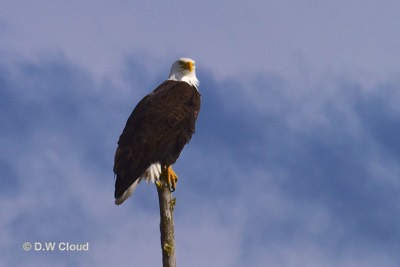The Bald Eagle
by D.W. Cloud

It is a massive raptor about three feet high, weighing 9 to 14 pounds, with a wing span of six to eight feet, second in size only to the California condor. The female is one-third larger than the male.
Its habitat covers most of North America and northern Mexico.
Its head and tail feathers are brilliant white, its body and wings are chocolate-brown, and its legs and bill are bright yellow. Young bald eagles do not develop the white heads and tails until about five years of age.
It has amazing eyesight, with the frontal setting of the eyes giving it binocular as well as peripheral vision. It can see prey from a mile and more away while soaring in the air or perching in tall trees.
It can fly at an altitude of 10,000 and more feet and often travels 100 and more miles a day, ingenuously riding air thermals.
The bald eagle can reach speeds of more than 35 miles per hour in level flight and dive at speeds of 100 mph.
The bald eagle is a masterpiece of weight reduction and micro-engineering. Its bones are hollow, with braces at certain points to increase structural integrity, the entire skeleton weighing only a little more than half a pound. This allows the bird to be light enough to take off and fly but strong enough to swoop down on prey at high speeds and carry it away, etc.
A bald eagle has approximately 7,000 lightweight but very strong feathers, all of the feathers together weighing only about 21 ounces. The flying feathers consist of amazing interlocking microscopic structures consisting of barbs and barbules (each feather held together by more than 350,000 barbule hooks), and there are four types of flight feathers, with each playing a different and essential role in the bird’s ability to fly.
“Pound for pound, an eagle wing is stronger than a wing of an airplane” (The Bald Eagle’s Quest for Flight, Zoo Books, 1985).
The feathers trap layers of air to protect the bird from heat, cold, and rain, and a perching eagle controls the air pockets in its feathers depending on the climatic conditions.
The bird has perfect control over every part of the wings and tail for maneuverability, with the tail feathers serving as a rudder and stabilizer and adding to the wing surface for soaring.
The bald eagle can fly with prey weighing half its own weight and even more. If it catches prey so large that it cannot fly off with it, it can swim to shore using its wings as paddles.
It kills its prey with its powerful talons, which are capable of creating 1,000 pounds of pressure per square inch with each foot.
The bald eagle does not have a vocal cord but makes its high-pitched shriek via the air that passes through the bones in its neck.
The bald eagle’s favorite food is fish, but it will eat other birds, rabbits, other small animals, and will also eat carrion. In the Pacific Northwest, British Columbia, and Alaska, bald eagles congregate to feed on spawning salmon in the late fall and early winter. I saw probably 200 bald eagles in one 10 mile stretch of the Skagit River in Washington State in December 2012.
Bald eagles often harasses the smaller osprey until it drops its prey or sometimes even snatches the prey right from the osprey’s talons.
The bald eagle mates for life and the pair usually enlarge the same nest for several years. The nests can typically be up to 13 feet deep, 8 feet wide, and weigh one ton. The largest known nest, built by a pair of bald eagles in Florida, was 18 feet deep, 12 feet wide, and weighed nearly three tons.
The bald eagle was nearing extinction in 1967, with only about 400 known nesting pairs remaining, but they made a full comeback after being placed on the endangered species list.
A group of eagles riding a thermal is called a “kettle.”


